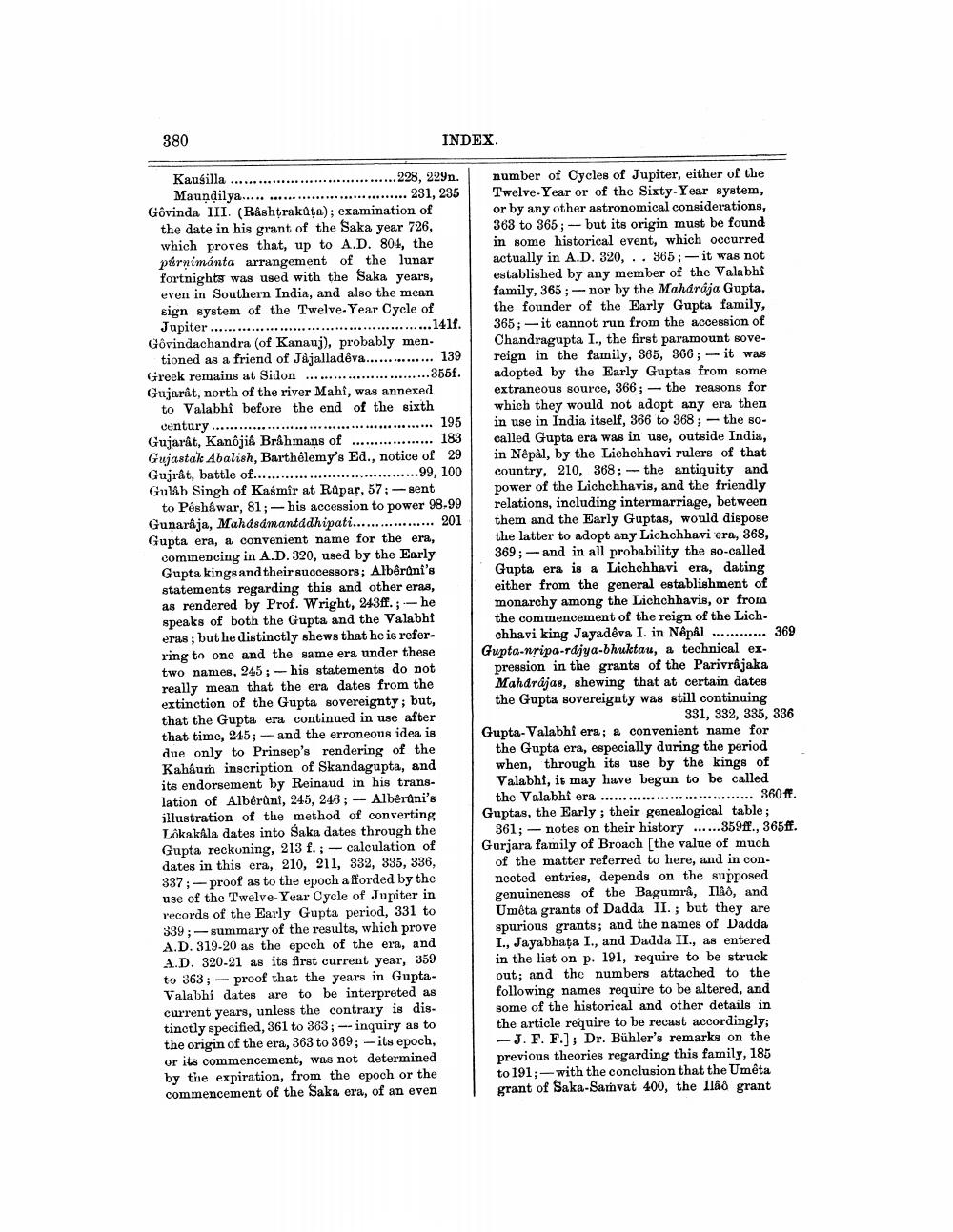________________
380
INDEX.
Kausilla ..................
.................228, 229n. Maundilya........... Govinda III. (R&shtrakata); examination of
the date in his grant of the Saka year 726, which proves that, up to A.D. 804, the párnimânta arrangement of the lunar fortnights was used with the Saka years, even in Southern India, and also the mean sign system of the Twelve-Year Cycle of Jupiter ...............
...............141f. Govindachandra (of Kanauj), probably men.
tioned as a friend of Jajalladêva............... 139 Greek remains at Sidon ..........................355. Gujarat, north of the river Mahf, was annexed
to Valabhi before the end of the sixth
century ......................... ...................... 195 Gujarat, KanojiA Brahmans of .................. 183 Gujastak Abalish, Barthélemy's Ed., notice of 29 Gujrat, battle of.................................... 99, 100 Gulab Singh of Kasmír at Rapar, 57; - sent
to Peshawar, 81;- his accession to power 98-99 Gunaraja, Mahdsdmantadhipati.................. 201 Gupta era, a convenient name for the era,
comiencing in A.D. 320, used by the Early Gupta kings and their successors; Albêrani's statements regarding this and other eras, as rendered by Prof. Wright, 243ff.; -- he speaks of both the Gupta and the Valabhi eras; but he distinctly shews that he is referring to one and the same era under these two names, 245; - his statements do not really mean that the era dates from the extinction of the Gupta sovereignty; but, that the Gupta era continued in use after that time, 245; - and the erroneous idea is due only to Prinsep's rendering of the Kahâum inscription of Skandagupta, and its endorsement by Reinaud in his translation of Albêrûni, 245, 246; - Albêrani's illustration of the method of converting Lôkakala dates into Saka dates through the Gupta reckuning, 213 f. ;-calculation of dates in this era, 210, 211, 332, 335, 336, 337;-proof as to the epoch afforded by the use of the Twelve-Year Cycle of Jupiter in records of the Early Gupta period, 331 to 339; - summary of the results, which prove A.D. 319-20 as the epech of the era, and A.D. 320-21 as its first current year, 359 to 363; - proof that the years in GuptaValabhi dates are to be interpreted as current years, unless the contrary is distinctly specified, 361 to 383; -- inquiry as to the origin of the era, 363 to 369; - its epoch, or its commencement, was not determined by the expiration, from the epoch or the commencement of the Saka era, of an even
number of Cycles of Jupiter, either of the Twelve-Year or of the Sixty-Year system, or by any other astronomical considerations, 363 to 365; - but its origin must be found in some historical event, which occurred actually in A.D. 320, . . 365; - it was not established by any member of the Valabhi family, 365 ; - nor by the Maharaja Gupta, the founder of the Early Gupta family, 365; -it cannot run from the accession of Chandragupta I., the first paramount sove. reign in the family, 365, 366; - it was adopted by the Early Guptas from some extraneous source, 366; - the reasons for which they would not adopt any era then in use in India itself, 366 to 368; - the socalled Gupta era was in use, outside India, in Nepal, by the Lichchhavi rulers of that country, 210, 368; - the antiquity and power of the Lichchhavis, and the friendly relations, including intermarriage, between them and the Early Guptas, would dispose the latter to adopt any Lichchhavi era, 368, 369; -and in all probability the so-called Gupta era is a Lichchhavi era, dating either from the general establishment of monarchy among the Lichchhavis, or frona the commencement of the reign of the Lich
chhavi king Jayadeva I. in Nepal ............. 369 Gupta-nripa-rdjya-bhuktau, a technical ex.
pression in the grants of the Parivrâjaka Mahdrájas, shewing that at certain dates the Gupta sovereignty was still continuing
331, 332, 335, 336 Gupta-Valabhi era; a convenient name for
the Gupta era, especially during the period when, through its use by the kings of Valabhi, it may have begun to be called
the Valabhi era .............. .............. 360 IF. Guptas, the Early; their genealogical table;
361; - notes on their history ....... 359ff., 365ff. Gurjara family of Broach (the value of much
of the matter referred to here, and in connected entries, depends on the supposed genuineness of the Bagumra, nað, and Umêta grants of Dadda II. ; but they are spurious grants; and the names of Dadda I., Jayabhata I., and Dadda II., as entered in the list on p. 191, require to be struck out; and the numbers attached to the following names require to be altered, and some of the historical and other details in the article require to be recast accordingly; - J. F. F.]; Dr. Bühler's remarks on the previous theories regarding this family, 185 to 191;- with the conclusion that the Umêta grant of Saka-Samvat 400, the Ilão grant




